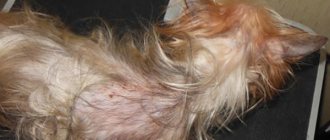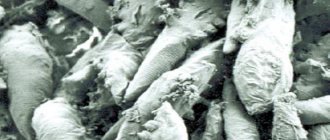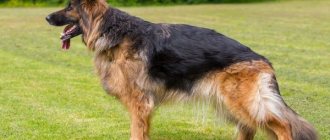Symptoms and treatment for urolithiasis in dogs differ from those in cats. The symptoms that appear in canines are less pronounced, which hinders timely diagnosis. Because of this feature, owners need to more carefully control their pets’ urination and not forget about preventive recommendations.
General information about urolithiasis in dogs
Urolithiasis is the process of formation of sand and stones in the kidneys and bladder. Just like in humans, urolithiasis in dogs is accompanied by very painful sensations. The animal whines, takes strange poses and appears frightened during simple urination. If you suddenly notice changes in your pet’s behavior described above, then under no circumstances delay visiting the veterinarian. The dog is in a lot of pain, and it will get even worse later!
There are quite a few types of stones formed in the animal’s body. All of them consist of various microelements. There are also many reasons for the occurrence of ICD. Without understanding the causes of the disease and what type of stone we are dealing with at the moment, it is impossible to prescribe the correct treatment.
Stones in the urethra and bladder in a male dog
Treatment methods
Further therapy depends on the form of the disease and the type of stones. Sometimes a simple change in diet is enough to help your pet recover, and sometimes the only solution is emergency surgery.
Despite the variability of possible solutions, in all cases the primary task is to remove accumulated urine by cleansing the urinary ducts. On average, the process of destruction of urinary stones is 1-4 months.
Catheterization
In case of anuria, the animal is given a catheter to drain urine and wash the ducts. The procedure is performed under general anesthesia. Catheterization allows you to create back pressure inside the urethra, which helps push the formed stones back into the bladder, bypassing the operation.
Also, insertion of a catheter may be necessary if renal failure is detected. In this case, the four-legged patient needs blood purification. For this purpose, hemodialysis is performed.
Removing Stones
If catheterization and drug therapy do not give the desired effect, then the outflow of urine is quickly restored. For this purpose, several operation options are used:
- Cystostomy
. The surgeon cuts the bladder at the site where the stones are deposited and removes them out. Before the stitches heal, the pet urinates through the catheter. The disadvantage of this operation is the high probability of narrowing of the ducts and their re-clogging.
- Urethrostomy
. This operation involves widening the natural opening in the urethra. To prevent its overgrowth, mandatory castration is recommended for all male dogs.
- Retrograde urohydropulsion
. The stones are pushed back into the bladder, where they are removed using a cystostomy.
Some formations are amenable to pulsed magnetic therapy. This procedure is based on a low-frequency magnetic field that breaks stones into smaller pieces. In this case, they leave the body on their own.
Drug therapy
If a secondary infection or inflammatory process is detected, the pet is prescribed antibiotics. Together with them, it is recommended to take hepatoprotectors, probiotics and immunomodulators. These drugs help relieve the load on the liver, normalize intestinal function and restore the body's defenses.
For severe pain, antispasmodics and painkillers are prescribed: Papaverine, Baralgin and No-Shpu. For acute pain, novocaine blockade is recommended.
Urine concentration is reduced with diuretics. They increase its rate of formation, stimulating the removal of stones and preventing the deposition of new ones. It is also recommended to use herbal infusions and mineral water.
Causes of urolithiasis in dogs
In most cases, stones form directly in the animal's bladder. Much less often - in the kidneys. All the causes of the formation of urolithiasis, or, as it is also called, urolithiasis, are not fully known. But the main ones have long been proven:
- genetic predisposition. If your pet's parents had urolithiasis, there is a high probability that he himself will develop this disease;
- breed. Unfortunately, small breed dogs (dachshunds, pugs, hounds, bulldogs, etc.) are much more likely to be diagnosed with urolithiasis;
- congenital pathologies. Many factors in a dog’s body influence the formation of urolithiasis. Impaired metabolic processes, kidney disease, liver disease and even vascular disease can lead to the formation of urolithiasis;
- Almost any infection can lead to the formation of urolithiasis. Especially urinary tract infections;
From natural causes we move on to causes that arise as a result of incorrect content.
The first of them is an unbalanced diet. Very often, owners want to do what’s best: give their pet, who is used to eating dry food, a tasty morsel from their table. Or, conversely, due to lack of time, feed a dog that is accustomed to natural food with crackers from a bag. All this, as well as an excess of proteins and carbohydrates (you should not feed the dog only meat or cereals) are some of the main reasons for the formation of urolithiasis.
Besides:
- Don't make your dog endure it. Walk with her as often as possible! Urine that has been in the animal’s body for a long time begins to crystallize. That is, to turn into those same stones;
- Insufficient activity leads to obesity. And obesity leads to stagnation of fluid in the body, including urine;
- drink. Intermittent access to water, or drinking untreated tap water contributes to the formation of sand in the dog’s body. Keep track of what your pet drinks!
Types of stones
The following types of uroliths predominate in dogs:
- Cystines.
- Oxalates.
- Struvite (triple phosphates).
- Urats.
Types of stones in urolithiasis
Cystines
Cystine stones are formed as a result of a hereditary anomaly. The amino acid precipitates in acidic urine. Dachshunds, Bulldogs, Newfoundlands are predisposed. Among dogs with undisturbed heredity, this is the rarest type of urotiliasis.
recommended articles:
- Kidney failure in dogs
- Why does my dog feel sick and diarrhea?
Oxalates
Stones from oxalic acid salts form in acidified urine. The stones quickly crystallize, have a branched structure and sharp edges. The stones are characterized by increased hardness. They are difficult to dissolve with medication. The provoking factor is:
- Excess protein.
- Fluid deficiency.
- Individual predisposition.
Variations in the size of urinary stones
Struvite
Formed in alkaline urine. They are a mixture of Phosphorus, Magnesium and Calcium salts.
Urine gradually washes away small pebbles that move along the ureters, injuring them, causing bleeding and pain in the dog.
When the urinary canal is blocked by urolith, urine stagnates and putrefactive microbes develop. Toxic metabolites are released. This condition can lead to the death of the dog.
Urats
Stones are formed as a result of crystallization of uric acid salts. They occur against the background of protein overfeeding, especially defective proteins and lack of water.
Symptoms of urolithiasis in dogs
Urolithiasis in dogs, the symptoms and treatment of which can vary dramatically even between two puppies from the same litter, is further complicated by the fact that it is very difficult to detect its signs at an early stage. The urine becomes slightly cloudy and its quantity decreases slightly. By the time the dog begins to show obvious signs of discomfort and pain, the disease has progressed greatly. Remember: urolithiasis does not happen overnight! If your pet is examined and tested at a veterinary clinic at least once a year, you will prevent the development of the following symptoms:
- frequent urination. The dog pees a little at a time and cannot always wait until the next walk;
- the pet begins to lick the genitals frequently;
- the urine becomes very cloudy or takes on a pinkish or even dark red color. The presence of blood and sometimes pus in it is noticeable;
- lethargy, apathy, the dog begins to refuse food.
If the disease is completely neglected, blockage (obstruction) of the urinary tract occurs. This makes the symptoms even worse. The dog begins to pee a few drops at a time, experiencing very painful sensations. There is more and more blood in the urine, appetite worsens, and signs of anorexia appear.
As a result, the pet begins to vomit frequently, convulsions appear, the temperature rises, and the dog completely stops going to the toilet. At this stage of the disease, death is possible; the clock literally counts. You should consult a doctor immediately!
Diagnosis of urolithiasis in dogs
To diagnose urolithiasis in your pet, the doctor will first take fresh urine for analysis. It is very important that the waste product is collected immediately before the study. If the urine has time to sit and cool, crystals will begin to form. Essentially the same sand. This will lead to an incorrect diagnosis. A urine test will help determine not only the presence of the disease, but also the type of stones. Let us remind you that the treatment tactics for urolithiasis in dogs depend on the type of stones. Different stones are treated differently. You cannot prescribe a course of tablets or injections without making sure which stone you are treating. A panacea for one can accelerate the growth of another urolith.
Next, in order to understand exactly where the stone is located, what size it is, and also to assess the general condition of the body, the doctor will do an ultrasound and possibly an x-ray. In addition, a biochemical blood test may be necessary to make a diagnosis.
Stones in a dog's bladder
Remember: only after the doctor has collected a complete history, asked about the symptoms, and conducted the necessary research, can he correctly prescribe a course of treatment. Otherwise, if the disease has not been studied thoroughly, treatment will turn into Russian roulette. Whether you're lucky or unlucky.
Dog Bladder Stones
Causes
The following predisposing factors for the occurrence of urolithiasis in dogs have been established:
- Urogenital infections.
- Unbalanced diet for dogs.
- Fluid and salt exchange disorders.
- Adynamia.
- Congenital anomalies.
- A combination of factors.
Urogenital infections.
An infection, mainly Staphylococcus, enters the urinary canals with blood or lymph. Their metabolites affect the pH of urine, which reduces the solubility of salts, causing crystallization of stones. The embryo of a microlith is any solid formation, for example, a dead cell.
Chocolate can cause urolithiasis
Unbalanced diet
The occurrence of pathology is provoked by loving owners who feed the dog with leftovers from their dinner and delicacies. If you feed your pet only meat or other protein foods, the urine becomes acidic and the preconditions for the formation of stones arise. The same result is caused by the stinginess of the owners, who try to reduce the cost of the dog’s diet by using low-quality by-products - chicken paws or kaltyks. Those who like to cook porridge from derti often purchase products contaminated with mycotoxins, which also contributes to the occurrence of pathology. Excessive consumption of cereals and potatoes leads to protein deficiency and alkalinizes the urine.
On the way to the ICD
Fluid and salt exchange disorders.
It occurs as a result of water shortage or poor quality. Tap water is often oversaturated with calcium and magnesium salts. If the water in the bowl is rarely changed, algae and bacteria develop in it, the pH shifts to the alkaline side, and toxins accumulate. If the dog refuses to drink, the concentration of salts increases, leading to their crystallization.
Adynamia
Irregular walking leads to disruption of the metabolism of salts and moisture. A dog living in an apartment is taught to endure, the urine stagnates, and sediment forms. Reduced loads cause obesity, edema, prolonged presence of urine in the urinary canals, which contributes to the formation of stones.
Adynamia
Congenital anomalies
Man changed the dog's genotype and created breeds prone to hereditary diseases. Yorkies and Schnauzers are predisposed to struvite IBD, Pekingese and Shih Tzus are predisposed to oxalate, and Dalmatians are predisposed to urate. Cystine stones are formed mainly in male English Bulldogs, Bassets and Dachshunds.
Set of factors
The combination of the above reasons for the formation of stones increases the risk of developing urolithiasis.
Treatment of urolithiasis in dogs
Treatment of urolithiasis in dogs, regardless of the type of stones, should first begin with the removal of stagnant urine. This will make your pet's condition a little easier. After your dog's bladder has been emptied, your doctor will tell you what to do next.
Depending on how far urolithiasis has developed in dogs, the treatment of the disease will be radically different. For some, it is enough to go on a diet, while others will have to resort to surgery. And again: any appointments will depend on the type of stones. Even the diet, as you understand, for removing alkaline formations and uroliths that have arisen in an acidic environment will be significantly different.
As a rule, urolithiasis in dogs is treated with traditional methods: the urinary tract is washed, a course of medications is prescribed, and a strict diet is prescribed. If the disease is advanced, surgical intervention will be required before carrying out therapeutic measures. From time to time, doctors may resort to non-standard methods of influence. But remember: if the doctor insists on surgery, then it is really necessary! Don't risk your pet's life! Self-medication has never brought any good to either people or dogs.
Prevention of urolithiasis in dogs
Prevention of urolithiasis in dogs, first of all, consists of proper care. If your pet has already had urolithiasis, strictly follow the instructions and prescriptions issued by your veterinarian.
If the animal is healthy, remember a few simple rules that will reduce the likelihood of urolithiasis to a minimum:
- feed your dog correctly: either only dry food, which is selected specifically for your pet, or only natural food. Remember: you cannot mix dry and natural food. Even in small quantities! And, most importantly, the dog’s food should include all the necessary minerals and beneficial elements;
- Eliminate raw tap water from your dog's diet. Give your pet either boiled or filtered. And make sure that there is always water in the bowl, especially in the warm season. In summer it is also worth taking a drink with you on walks. Are you thirsty in the heat? Your pet too;
- Walk your dog more often. Spend at least two hours walking a day. Try to get your dog to go outside at least once a day.
- Run, play, watch the physical development of your tailed friend! Do not let your dog lie in one place for days;
- Provide your pet with its own place. Lying on a cold floor is harmful. This also leads to the formation of ICD;
- Get tested at a veterinary clinic at least once a year. Especially if the animal is at risk. Remember: the earlier you detect the disease, the easier your dog will tolerate treatment. The pet will not be in excruciating pain, surgery will be avoided, and the family budget will remain much safer. Yes, prevention is always better than treatment for an advanced disease!
Farmina Vet Life Oxalate dry food for dogs with urolithiasis (oxalates, urates and cystitis) (Code: 49024)
Product description
Farmina Vet Life Natural Diet Oxalate Canine dry veterinary food for urolithiasis (oxalates, urates and cystitis)
Farmina Vet Life Oxalate Canine Diet. Limiting the formation of uroliths of the urate, oxalate and cystine type. Alkalinization of urine. Farmina Vet Life Oxalate is a dietary food for dogs for the treatment and prevention of urolithiasis of the urate, oxalate and cystine type. Also recommended for patients with kidney disease.
INGREDIENTS: Rice, oats, animal fat, dehydrated whole eggs, flaxseed, hydrolyzed animal protein, sugar beet pulp, fish oil, calcium carbonate, vegetable oil, sodium chloride. Protein Source : Dehydrated whole eggs. Urine alkalinizer: potassium citrate (9g/kg). The total amount of vitamin D is 650 IU.
FOOD SUPPLEMENTS PER KG: Vitamin A 15000 IU, Vitamin D3 600 IU, Vitamin E 600 mg, Vitamin C 150 mg, Niacin 38 mg, Pantothenic acid 15 mg, Vitamin B2 7.5 mg, Vitamin B6 6 mg, Vitamin B1 4.5 mg, Vitamin H 0.4 mg , Folic acid 0.45 mg, Vitamin B12 0.06 mg, Choline chloride 2000 mg, beta-carotene 1.5 mg, zinc chelate similar to methionine hydroxylase 970 mg, manganese chelate similar to methionine hydroxylase 400 mg, iron chelate glycine hydrate 185 mg, copper chelate similar to methione in hydroxylase 13, 5 mg, selenomethionine 68 mg, anhydrous calcium iodate 2.4 mg, taurine 1000 mg, L-carnitine 250 mg. Special additives: microcrystalline cellulose. Antioxidants: natural tocopherol extract 10 mg.
NUTRIENTS: Crude protein 9.50%, crude fat and oils 19.00%, crude fiber 1.90%, crude ash 3.80%, calcium 0.30%, phosphorus 0.20%, sodium 0.20% , potassium 0.60%, magnesium 0.04%, chlorides 0.50%, sulfur 0.15%, hydroxyproline <0.02%, total sulfur-containing amino acids 0.50%, Omega-6 2.80%, Omega- 3 0.50%, EPA 0.10%, DHA 0.25%.
ENERGY VALUE: EM Kcal/Kg 3990 – Mj/Kg 16.69
Farmina Vet Life Natural Diet is a new revolutionary veterinary line of all-natural products from Farmina Pet Foods. Nature is the guiding principle of Farmina's philosophy, expressed in new nutritional products created after long and careful research carried out in collaboration with the Department of Veterinary Dietetics of the University of Naples Federico II. The experience gained in developing ideal nutritional strategies that match the physiology of cats made it possible to conduct Farmina Vet research to create the first natural diet.
Only natural antioxidants , extracts rich in tocopherols, which ensure the natural preservation of the product.
Without GMOs (Genetically Modified Organisms) . The European Union allows but strictly regulates the use of GMOs in accordance with the precautionary principle. Farmina eliminates potentially modified ingredients (such as corn) from any product formula and replaces them with non-GMO ancestral grains (spelt and oats)
Ancestral grains have a low glycemic index , making them suitable for use in postprandial glycemia. Farmina Vet Life Natural Diets products are packaged in such a way as to protect against fat oxidation and keep the product fresh.
Respect as the basis of scientific research. One of the leading characteristics of the scientific trials carried out by FVR was the decision to collaborate with dozens of independent veterinary clinics throughout Italy, which offered a nutritional system for cats and dogs that had already suffered from diseases. Pets now have the chance to improve their condition while remaining with their families for the duration of the study, without any lifestyle changes other than a diet that is respectful of the animal.
DISCOVER FARMINA VET LIFE , THE BEST ASSISTANT FOR YOUR PET'S WELL-BEING. FOR EVERY PROBLEM THERE IS A SOLUTION, THE RIGHT SOLUTION.
Nutrition for dogs with urolithiasis
What to feed a dog with urolithiasis? Your veterinarian will tell you about this. Let us remind you that with different types of uroliths formed in the body, the diet for dogs with urolithiasis will differ significantly. Different animals require different minerals and trace elements for successful recovery. Most manufacturers produce medicinal dog food for urolithiasis. Your doctor will explain in detail what kind of food your pet should eat and why. Natural nutrition for urolithiasis in dogs is also prescribed by a veterinarian. The diet should consist of different foods - porridge, meat, vegetables. Fatty, fried, sweet and salty foods are completely excluded from the animal's diet. Do you want to extend the life of your pet? Do you want to make sure that the disease does not return? Strictly monitor your dog's diet!
Prognosis for urolithiasis in dogs
In most cases, urolithiasis in dogs is not treated, but stopped. This should be remembered first of all by owners who have seen the effect of treatment. No, nothing is over! Very often, people who notice that their pet is feeling better stop following the diet and taking medications. Don’t even think about doing this: refusing treatment will return all the symptoms and excruciating pain to your dog in a matter of weeks!
In general, the prognosis is favorable. But only with strict adherence to the instructions, otherwise a relapse cannot be avoided. Follow a diet, walk more, take medications strictly according to instructions and periodically get tested at a veterinary clinic, then the life of your beloved dog will be long, happy, and illnesses will pass and be forgotten!
Clinical case of treatment of acute urinary retention with urinary tract disease in dogs
A Scottish Terrier dog named Vicky was admitted in emergency condition with acute urinary retention. Based on the results of diagnostic tests and examination by a veterinarian, a diagnosis was made: acute urinary retention due to blockage of the urethra by stones with a diameter of 10 mm. Doctor Andrey Konstantinovich Mamedkuliev decided to prescribe surgical treatment with further cystotomy and removal of stones from the urethra. During the operation, stones were removed and the urethra and bladder were washed.
The treatment and surgery were successful. Now Vicky can empty her bladder freely and not experience any pain.
Saint Bernards
Natural food for animals with a tendency to urolithiasis using the example of Dalmatian dogs.
Again, the Dalmatian's diet should prevent the formation of uric acid, but should be rich in foods containing vitamins, minerals and fatty acids. The best foods for such a diet would be the following foods that are moderate in purine content: chicken wings, chicken necks, chicken backs and tails, turkey necks, chopped and stewed vegetables, including large amounts of greens; eggs, cottage cheese, homemade cheese, yogurt, olive oil, flaxseed oil and peanut oil. In addition, the diet should contain vitamin B complex, vitamin E, and fish oil (cod). Consumption of offal should be kept to a minimum and ensure that the dog receives plenty of fluids. And, although natural food contains a sufficient amount of moisture, it is worth giving more liquid so that the urine is as neutral as possible and uric acid is eliminated well. At the same time, do not underestimate the importance of long-lasting and active products that promote good elimination of harmful substances. In addition, you should not force dogs to endure for a long time - this leads to an overflow of the bladder and an increase in the concentration of uric acid. When transferring a Dalmatian to natural feeding, tests should be done - ultrasound, blood biochemistry, urine analysis - to make sure that urolithiasis has not begun and, depending on the results, adapt the diet. In addition, at the initial stage of transferring a dog to BARF, tests should be quite frequent to ensure that the body is functioning normally and adaptation has been successful. In fact, for Dalmatians, as dogs at risk for urolithiasis, tests every six months are a necessity.
Natural food for animals with a tendency to urolithiasis using the example of Dalmatian dogs.











